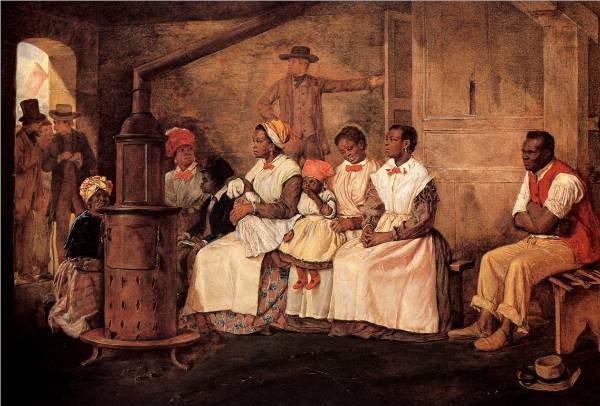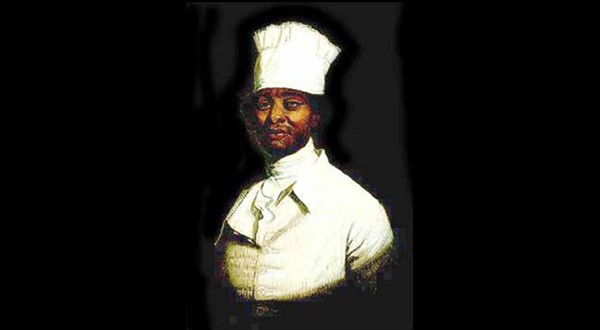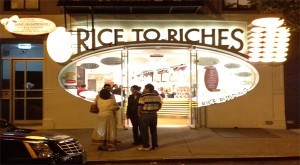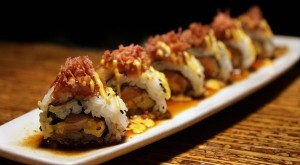Thomas Jefferson is known as a founding father and a founding foodie. Less well-known is the remarkable man who once fed his refined palate: James Hemings.
In the 18th century, Hemings was one of America’s most accomplished chefs. He was also Jefferson’s slave. “It was a close relationship, a master-slave relationship, but different,” says Jefferson historian Annette Gordon-Reed.
Different, because Hemings and his relatives weren’t just property to Jefferson: They were also family. Hemings was the son of an enslaved mulatto woman named Elizabeth Hemings and a white father, John Wayles — who was also the father of Jefferson’s wife, Martha. James Hemings and his relatives became Jefferson’s property as part of Martha’s inheritance.
After gaining his freedom, but before leaving Monticello, James Hemings penned this exhaustive catalog of the tools in the kitchen he had run for years. Hemings grew up as a household slave in Monticello, Jefferson’s rural Virginia estate. He could read and write, and was said to be very bright. Jefferson trusted him and relied on him, says Gordon-Reed.
So when Jefferson sailed to France in 1784 to become America’s trade minister, he brought the 19-year-old Hemings with him for an express purpose: to become a French-trained chef. Paris was then the culinary capital of the world, and Hemings spent five years in the city, mastering the art of French cuisine. His training was extensive: He apprenticed with a caterer, a pastry chef and even a chef of the Prince de Conde, who was known for the splendor of his table.
“For an American to go and learn that — enslavement aside — was pretty incredible,” says food historian Paula Marcoux, who has re-created classic French dishes of the era at Monticello, using the same types of cooking tools Hemings would have used. On a recent day in the Monticello kitchen, she was working on “snow eggs,” a Hemings recipe the Jefferson family preserved through the generations: puffs of meringue poached in milk syrup and served chilled over English custard. She says his technique was strikingly sophisticated, and his training certainly surpassed other American chefs of the era.
In 1787, Hemings took over as chef de cuisine at Jefferson’s stately Paris home. It was a big job: It meant he supervised other, white servants in the kitchen — something impossible to imagine happening under the strict racial strictures of slave-era Virginia. But Paris offered an altogether different life than the one Hemings had left behind. He moved freely around the city. He had money in his pocket because Jefferson paid him wages — money he used to hire a French tutor. And Gordon-Reed says his world was populated with free blacks — not just servants but businesspeople, respected artists and craftsmen.
“He would have seen people of his race, people who looked like him, who occupied a very different position in the world,” Gordon-Reed says. One of the people in his Paris world was Hemings’ sister Sally – yes, that Sally Hemings, the enslaved woman believed to have born several children with Jefferson. Sally arrived in 1787 with one of Jefferson’s daughters. Historians believe Sally Hemings’ relationship with Jefferson began during her stay in the city of lights.
According to Historian Annette Gordon-Reed: It was a city on the cusp of revolution. Talk of the rights of man filled the streets. And at some point, James and Sally Hemings learned a startling fact: Under French law, they could have sued for their freedom. But they choose not to do so.
“Family,” says Annette Gordon-Reed. “There was a real dilemma for many enslaved people: Do you take your freedom and separate yourself from your family?” Instead, the Hemings siblings agreed to return to America — and to slavery — with Jefferson in 1789. At the time, Gordon-Reed says, James Hemings thought he’d have another chance to pursue his freedom in Paris: The trip home was supposed to be temporary for Jefferson and James Hemings. But once back in the U.S., Jefferson became George Washington’s secretary of state.
Hemings spent several more years in Jefferson’s service in various cities, including New York and Philadelphia. But then, when Jefferson decided to return to Monticello in 1793, Hemings did something remarkable: He pressed Jefferson to free him. In 1793, Thomas Jefferson promised to free James Hemings if he would first return to Monticello and train a replacement chef. In his sworn promise, he first notes he incurred “great expense” in arranging for Hemings’ culinary training.

“Of the 607 people that Jefferson owned over the course of his lifetime, there were only two that really negotiated their freedom. James Hemings was one of them,” says Susan Stein, senior curator at Monticello. As part of his deal with Jefferson, James Hemings spent the next three years training his little brother, Peter, to replace him in the kitchen. Then, at 31, Hemings became a free man.
But freedom was far different for a black man in America than it had been in Paris. He was a man adrift, searching for his place in the world. He traveled a lot — so much that Jefferson worried that Hemings’ journeys would “end in the moon.” Eventually, in 1801, Hemings landed in Baltimore. “He was cooking for a tavern keeper there,” Stein says. “So this was a far cry from his expectation of his future.”
Meanwhile, Thomas Jefferson had become president — and he asked Hemings to be his personal chef. Hemings refused, but he did agree to cook at Monticello one last time. That was in the summer of 1801. A month after he left Monticello, word came: Hemings was dead, an apparent suicide. “We’re thinking that James Hemings must have had ideals and aspirations about his life that could not be realized in his time and place,” Stein says. “And those factors probably contributed to his unhappiness and his depression, and ultimately to his death.”
It’s impossible to know for sure how he felt; the great chef left no memoirs. But he did leave recipes — and as Marcoux whips up “snow eggs” in Monticello’s historic kitchen, Hemings’ dishes, and his legacy, live on.
Source: NPR





